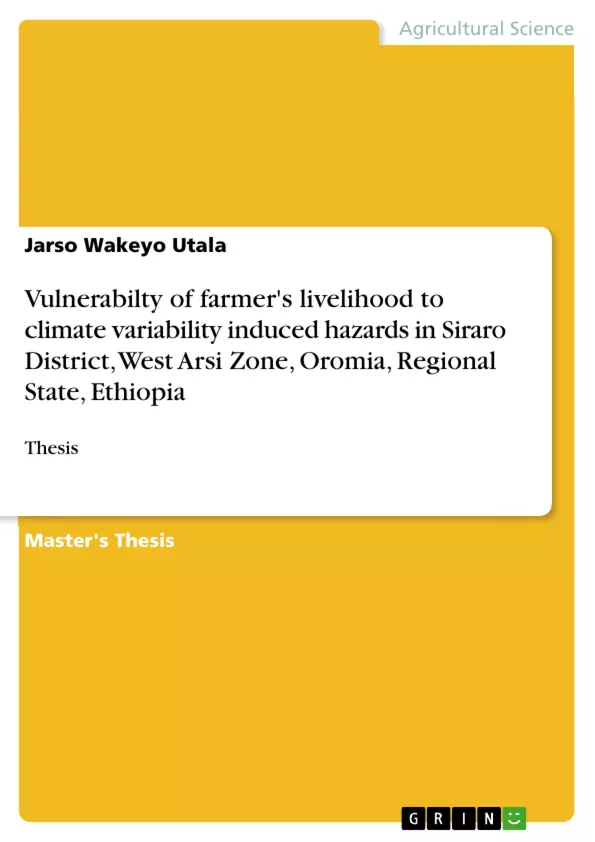Most previous studies on vulnerability of smallholder farmer’s livelihood to climatic hazards had focused on large scale, global, regional or national levels. In addition, they gave more focuses to assessment of impacts of climatic hazards to farmers than assessment of farmer’s vulnerability to climatic hazards. Thus, this study was designed to bridge this gap by assessing vulnerability of farmer’s livelihood at household level measured as perceived sensitivity and lack of adaptive capacity to climatic hazards and by exploring sets of socioeconomic indicators that significantly determine vulnerability of farmers’ livelihoods. Cross-sectional data was collected through household survey from 379 randomly selected respondents which were also complemented with qualitative assessments. Principal component analysis was used to identify major socioeconomic indicators that contribute to vulnerability of farmer’s livelihood using orthogonal axis rotation in SPSS version 20. Binary logit model was used to identify principal socioeconomic indicators that significantly influence sensitivity and adaptive capacity of livelihoods of sampled farmers. The findings revealed that households that are heterogeneous in location of residence, sources of income, ownership to animals have significant influence on perceived sensitivity of farmers to climatic hazards. However, socioeconomic indicators such as age, gender, family size, have insignificant influence on sensitivity of farmer’s livelihood to climatic hazards. Gender, marital status, educational status of household head, coping mechanisms like grain & cash saving, NRM practices has significant influence on perceived adaptive capacity of farmers. Yet, access to social interconnectedness such as idir or iqub, family relatives, and cost of drinking water has insignificant influence on perceived adaptive capacity of farmers. Currently, 59%, 38% and 3% of sampled farmers have overall vulnerability status of low, moderate and high respectively. The overall conclusion is that differences in status of vulnerability of their livelihoods are attributed to differences in their present socioeconomic attributes. Community should strengthen existing hazard coping mechanisms whilst GOs and NGOs should support farmers in diversification of income sources and restocking of animals. Active community engagement in planning and execution of disaster risk reduction strategies and practices is also indispensable.
Inhaltsverzeichnis (Table of Contents)
- Chapter I: Introduction
- 1.1 Background of the study
- 1.2 Statement of the problem
- 1.3 Objectives of the Study
- 1.3.1 General Objective
- 1.3.2 Specific Objectives
- 1.4 Research Questions
- 1.5 Significance of the study
- 1.6 Scope of the study
- 1.7 Limitation of the study
- 1.8 Organization of the study
- Chapter II: Related Literature Review
- 2.1 Conceptual Literature
- 2.2 Definitions
- 2.3 Conceptual framework
- 2.4 Empirical Literature
- 2.4.1 Descriptive Analysis
- 2.4.2 Indicators Approach
- 2.4.3 Econometric Approach
- 2.4.4 Integrated Method
- 2.4.5 Principal Component Analysis
- 2.5 Literature gaps
- Chapter III: Description of the Study Area and Methods & Materials
- 3.1 Brief description of the study area
- 3.1.1 Location
- 3.1.2 Socioeconomic status of Siraro district Farmers
- 3.1.3 Demographic features
- 3.2 Research Methods and Materials
- 3.2.1 Study design
- 3.2.2 Data Types and Sources
- 3.2.3 Sampling Techniques and Sample Size Determination
- 3.2.4 Data Collection Methods
Zielsetzung und Themenschwerpunkte (Objectives and Key Themes)
The study aims to assess the vulnerability of farmer livelihoods to climate variability-induced hazards in Siraro District, Ethiopia, focusing on household-level vulnerability measured as perceived sensitivity and lack of adaptive capacity. This study seeks to identify the socioeconomic indicators that significantly influence vulnerability, ultimately providing insights for developing strategies to improve resilience to climatic hazards.
- Vulnerability of smallholder farmers' livelihoods to climatic hazards in a specific context.
- Assessment of farmers' perceived sensitivity and adaptive capacity to climate-related challenges.
- Identification of key socioeconomic factors that contribute to vulnerability and resilience.
- Analysis of the influence of different socioeconomic indicators on vulnerability levels.
- Developing recommendations for strengthening coping mechanisms and promoting resilience among farmers.
Zusammenfassung der Kapitel (Chapter Summaries)
Chapter I provides a detailed introduction to the study, outlining the background, problem statement, objectives, research questions, significance, scope, limitations, and the organization of the research. Chapter II delves into the relevant literature, exploring conceptual frameworks, definitions, and empirical studies related to farmer vulnerability to climate hazards. The chapter also identifies existing gaps in the literature, setting the stage for the current study. Chapter III presents a description of the study area, including its location, socioeconomic status of farmers, and demographic characteristics. It then outlines the research methods and materials, including study design, data types, sampling techniques, and data collection methods employed in the research.
Schlüsselwörter (Keywords)
The core concepts of the study revolve around smallholder farmers, vulnerability, climate variability, climatic hazards, livelihood, sensitivity, adaptive capacity, socioeconomic indicators, resilience, and coping mechanisms. These keywords reflect the study's focus on analyzing the vulnerability of farmer livelihoods to climate-related risks and identifying ways to enhance their resilience.
- Quote paper
- Jarso Wakeyo Utala (Author), 2016, Vulnerabilty of farmer's livelihood to climate variability induced hazards in Siraro District, West Arsi Zone, Oromia, Regional State, Ethiopia, Munich, GRIN Verlag, https://www.grin.com/document/461981



